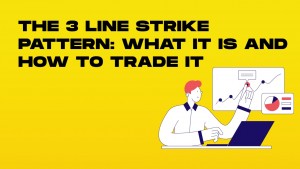Unlike automated trading systems (ATS) where investors often do not have to use the analytical process and make money through consistently performing grid trading systems and other strategies that rely on easily recognizable sequences and trader behaviors, experienced experts who know how to trade using order placement dependent on this specific arrangement of bars have to spend hours looking at their screens.
You can use this iconic figure successfully to identify promising entry points for an order placement system that relies on long-term positions. However, one must be aware of the risks and weaknesses of this particular method of forecasting trends.
We strongly believe that it can be used as a complimentary, supportive analytical approach that can confirm a trend identified through other means. However, making impactful financial decisions based on wonky predictions of a bar formation that can change dramatically depending on time frames is a risky proposition.
Understanding short-sequence trading
It is relatively easy to spot this configuration on any chart. First, you need to switch the view to the appropriate type. Then, look for any three consecutive candles. To form a reliable sequence associated with upward momentum, the candles must be arranged in a very specific order with certain criteria:
● Three consecutive periods (bars) with the closing price higher than prior similar values.
● The same arrangement with the lowest value is bigger than the previous lowest values.
● Four consecutive bars with the highest price bigger than the previous such values.
● The fourth bar has a low which is lower than the combined value of all closes is lower.
The opposite arrangement is true for the bearish three-line strike pattern. In essence, it means that the chart has several bars that suggest consistent price increases or decreases and the fourth one breaks the trend for a short period. Since the market data accumulates throughout the day, this particular analytical approach is often used on charts with periods of 1 day and higher.
With more information packed in each candle, the forecast seems to be stronger and more reliable. On the other hand, other proponents of the method believe that it can be used on shorter frames with the same level of consistency. It is hard to verify the validity of this approach for various time frames due to the inconsistency of outcomes. However, many investors believe that you can use the results of the analysis to confirm trend predictions.
How the three-line strike candlestick pattern works
The explanation of the prognosis is quite simple: several price action changes in a row that form a strong trend suggestion are often followed by sudden changes in the opposite direction that usually demand a long-term evaluation retracement. In a sense, the short burst of similar bars, one after another, is the period of preparation when the market is slowly building up momentum and tension that must be resolved in the near future.
Several foundational ideas of this method of studying the market can be employed to further support the argument as to why the approach works:
● The market tends to repeat its actions. People react to the same events similarly and many recognizable layouts are formed by repeated behaviors. In this case, the idea of the market preparing for a sudden change and correcting the price afterward works well.
● Many of them are parts of bigger figures. Many figures that are formed on charts can contain this particular sequence. For example, the Head and Shoulders figure can have this type of strike in either of the shoulders after which a trend reversal predicted by just a couple of bars becomes valid.
● The information is already in the price. Since this particular arrangement consistently repeats on the chart, it means that traders as a whole know something that each individual trader does not. The collective information about a certain market dynamic is baked into the current value of an asset making everything that repeats itself a good predictor of future trends.
● All movements must be retraced. Corrections or retracements happen all the time due to the overreaction of traders to certain events or sudden changes in market conditions. It means that any sufficiently strong trend is followed by opposing pressure that can have a powerful or barely noticeable effect overall but an impactful one locally.
These are reasons to believe that this particular analytical approach can be used in all markets. Since cryptocurrencies are inherently speculative assets that are heavily impacted by investor sentiment, using indicators and graphical tools is often more effective than fundamental approaches.
The advantages of the method
All configurations must be easily recognizable and understandable. It is not hard to notice a bullish type of this configuration on a chart. If you use the recommended 1-day period, you will have enough time to identify it, prepare a plan, and execute it. Even if it does not work all the time, it is still something that allows newcomers to avoid hesitation which can be even more harmful than entering a couple of bad trades.
Many experts believe that some qualities of this analytical method are great specifically for predicting the prices of various assets for several reasons:
● It can be easily identified on a chart. Finding an elusive figure is an important part of any visual analytical process. In this case, you can quickly find where this particular arrangement is forming. Since you don’t need to wait for all the bars to show up to start preparing, even finding two consecutive candles is enough to get ready.
● Risk management is quite simple. This trend-following trading method of seeking the arrangement and joining the market dynamic can be protected by using delayed orders (stop-loss and take-profit) or hedged with derivatives where you take an opposite position by short-selling an asset that you buy or creating a long position on the futures market while you sell.
● Training yourself to see it quickly is a good way to identify other useful formations. As mentioned previously, this sequence of bars can be a part of other figures like Head and Shoulders, Flag, Pennant, and others. These are more important and telling so you need to spot them quickly. By looking at bars consistently and searching for potential continuations of sequences, you will be noticing other figures more often.
● You don’t need additional analytical tools. One of the issues with indicators and figures is that you are often overwhelmed with information. Having several graphical tools that draw lines, curves, and shapes on the chart creates an illusion of control and sows seeds of doubt instead of providing you with actionable insights. Often, using analytical approaches like the one with a couple of simple bars is a much better approach.
These advantages make this method quite appealing to many newcomers and even some seasoned veterans who do not want to experience the annoying information overload. However, when trying to decide whether to use it in your portfolio, you must consider the downsides.
Disadvantages of any system based on this approach
The simplicity and consistency of the method often convince inexperienced investors that they do not need other analytical instruments, insights, and research to make an informed decision. Nothing can be further from the truth. We have already mentioned that the formation of the figure is often misleading. It may or may not become a part of a bigger signifier.
Here are some of the notable disadvantages:
● The possibility of false breakouts. Even time-tested combinations of time-tested indicators can have many false positive signals. Some complicated strategies that involve multiple rounds of confirmations can have these false alerts. In our case, the sudden spike in price action can be a signifier of a reversal and have no noticeable retracement.
● High volatility disrupts the analytical process and can form unreliable data sets within each bar. For instance, fluctuations can be rather small yet frequent suggesting a high degree of anxiety in traders. In such situations, the market can go in either direction and nobody can predict the trend. However, this skewed data may appear normal when looked at from the height of a 1-day period.
● This method can be somewhat reliably used only on certain time frames. If you try to catch these figures on M15 or lower, bars won’t have enough data baked in them to produce reliable readings. On the other hand, using this figure for a much longer period of 1 week is too unreliable and risky as you won’t be able to adjust your position.
Note that many iconic TA strategies are designed to be used as confirmation tools for other analytical methods. For instance, many retail traders employ fundamental methods to identify well-performing stocks and test their theories using the readings of indicators and charting tools. If they see a confirmation of their prognoses, they make a move.
The same system won’t work in the cryptocurrency market where assets cannot be analyzed through the prism of fundamental analysis. A very simple and easily identifiable configuration of bars starts looking very appealing and reliable when you don’t have any other information to base your forecasts on.
How to use all of this in trading?
There is a handful of main applications of this analytical method in practical trading:
- Confirm readings from other indicators. You can use the Stochastic or even Ichimoku Cloud to find moments when the market is ready to shift its course. The sequential bars method can be used to look at the situation from “above” and confirm a signal taking shape in indicators.
- Strategic placement of orders. The result of applying this analytical method to a chart can be used to align the trend with current support and resistance levels to identify the best moment to open a position.
- Identifying price retracements. Market corrections can be exploited to extract small profits consistently by catching the moment when the market is correcting its evaluation of an asset and tries to revert back to a “fair” value.
These tricks can be successfully used to effectively utilize any prognoses. This particular method works great too but only in very specific scenarios. On the other hand, one must always remember the inability of this particular figure to produce alerts for automation systems which are hugely popular among contemporary crypto traders with over 65% of all surveyed individual investors claiming to use automation to at least some degree.
Ignoring a powerful trading bot is like handicapping yourself in a race. In fact, many modern technical analysis techniques are less valuable today precisely because they cannot be automated to produce reliable outcomes over multiple trades. The effectiveness of most bar sequences falls off with the increase in the number of trades made using them.
Many analysts have used the strategy tester tool on TradingView to check the potential returns using historical market data. Many seemingly staple methods failed to produce any meaningful profits or lost money. Relying on them blindly is a sure way to financial ruin.
The main takeaway
The method seems like a great tool for many analysts who need something to confirm their predictions. However, the use of this method outside of niche applications, such as trying to find the right moment to enter the market or confirming readings of other indicators, produces mixed outcomes at best.
Learn how to identify it, use it when appropriate, and have fun. However, do not rely on it to be your most consistent money-maker.
























